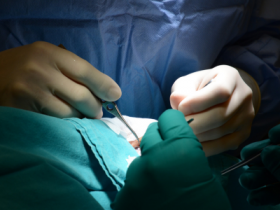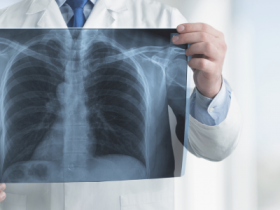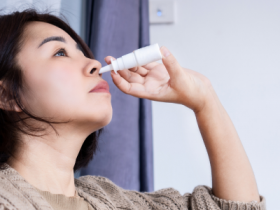Abstract
Chronic rhinosinusitis (CRS) is an important ENT pathology which affects about 5–12% of the general population. The treatment of CRS can be pharmacological (nasal sprays, douches, systemic antibiotics and steroids), surgical (endoscopic sinus surgery) or immunological according to established algorithms. CRS was divided for many years into CRS with nasal polyps (CRSwNP) and CRS without nasal polyps (CRSsNP). New ways of classifying CRS by endotypes (presence of neutrophilia, eosinophilia, fibrosis, glandular hypertrophy and epithelial dysmorphisms) appeared after the most recent understandings of the pathophysiology of the disease. Other classifications divide CRS into primary and secondary forms, localized/diffuse types and anatomical presentation. A new type of treatment has been administered in the last years, biologics. For the moment, biologics are indicated just in the cases of the patients who have undergone ESS or have contraindications for surgery and have bilateral polyps and meet a minimum of three of the following criteria: the necessity for systemic therapies with oral or parenteral corticosteroids or contraindications to systemic steroids, significant loss of smell or impaired QoL score, comorbid asthma and type 2 inflammation. This article aims to present the most relevant studies which used the three types of biologics (anti-IgE, anti-IL5 and anti-IL4/IL3) and wishes to increase the awareness of this new type of treatment that can be used in some CRS cases.
Introduction
Chronic rhinosinusitis (CRS) is defined as an inflammatory disease of the mucosa of nose and sinuses that lasts for more than 12 weeks without resolution of symptoms and signs. CRS is estimated to affect about 5–12% of the general population. CRS was classified by ENT specialists as CRS with nasal polyps (CRSwNP) or CRS without nasal polyps (CRSsNP). CRSwNP can be classified into eosinophilic CRSwNP (eosCRSwNP) or non-eosinophilic CRSwNP (non-eosCRSwNP) based on the extent of eosinophilic inflammation in the polyp tissues [1,2]. The diagnosis of CRS implicates medical history, physical examination with nasal endoscopy and, if necessary, imaging features of mucosal inflammation. The treatment of CRS includes pharmacological therapy with nasal sprays, douches, systemic antibiotics, steroids, immunomodulators and surgical intervention such as endoscopic sinus surgery (ESS). Biologics were used in the last years with success in order to reduce the need for surgery and increase the quality of life of patients.
Pathophysiology
The mechanisms implicated in CRS pathogenesis reveal a complex interplay between immunity, airway epithelium, genetics and environmental factors [2]. External factors (bacteria, viruses, fungi) and environmental factors (air pollution, dust, allergens) will activate TLRs (Toll-like receptors), epithelial proinflammatory cytokines production, epithelial defense molecules production, mucociliary clearance and solitary chemosensory cells activation. These factors will activate innate immune cells and adaptative immune cells. Chronic inflammation is the result of this activity with apparition of tissue remodeling, goblet cell hyperplasia, tight junctions disruption, activation of solitary chemosensory cells and bacteria dysbiosis. The clinical picture based on these modifications will translate into elements like nasal congestion and discharge, facial pressure or pain, and reduction in or loss of smell [2].
Chronic diseases have been classified by genotype, phenotype and/or endotype in order to understand the observed variability in the clinical picture and outcomes. Endotypes classification subdivides CRS based on pathobiological mechanisms such as the presence of an excess of neutrophils, eosinophils, elements of fibrosis, glandular hypertrophy and epithelial dysmorphisms. One way to endotype CRS is to use molecules produced by the T lymphocytes of types 1, 2 and 3 that produce the primary cytokines that drive the inflammatory patterns discovered in the tissues. T1 endotype is characterized by the preferential expression of IFN-γ, produced from Th1 cells, cytotoxic T cells, NK cells and group 1 innate lymphoid cells (ILC1s); T2 endotype is characterized by the IL-4, IL-5 and IL-13 produced from Th2 cells, mast cells and ILC2s and eosinophils; IL-17A and IL17F are produced from Th17 cells and ILC3 which are characteristic of T3 endotype. In addition to these leading markers, a number of other biomarkers belong to these endotypes: T1 (CXCL9, CXCL11, GZMH, ZNF683, FCRL6, SLCO1B3), T2 (EPX, CCL18, CCL26, CCR3, CST1, CST2, CLCA1, FCER2, POSTIN, PTGDR2, SIGLEC8) and T3 (IL1B, IL8, CXCL1, CXCL2, CXCL6, CCL20, CHI3L1, SAA1, SAA2, NOX1). Patients may fit in one of these endotypes or can present mixed mechanisms T1,2, T1,3 and T2,3. Few patients are T untypeable (Tun), which patients do not express elevated levels of any kind of biomarker genes, or the T1,2,3 endotype comprises a group of patients that have elevated levels of all three sets of biomarker genes with none of them being the most relevant [3]. Type 2 endotype is predominantly displayed in patients with CRSwNP in Western countries, whereas a mixed type 2 endotype is predominantly displayed on the Asian continent [4]. In addition to distinct immunological mechanisms between Asian and Western CRSwNP patients, different bacterial colonization was noticed [5]. Another way to endotype CRS is to use histopathology: paucigranulocytic, eosinophilic, neutrophilic and mixed granulocytic [6]. Grayson et al. proposed some years ago a simple and practical system of classification. They suggested that the functional anatomical compartments involved in CRS should be a diagnostic tool for the first level of separation into local and diffuse CRS, which can be unilateral or bilateral in distribution. “Pansinusitis” implies that diffuse means the disease is not confined to a known functional anatomical unit. Local anatomical factors are associated with pathogenesis in this classification [7]. Phenotypic classification is determined from the presence or absence of nasal polyps, and comorbidities define the phenotypic classification [8]. Epithelial cells play an important role, being an active component of the immune system of the nasal area and sinuses. They are crucial in the initiation and regulation of immune responses, playing roles in the prevention, development and progression of CRS by actively communicating with immune cells and orchestrating immune responses [9]. A team of experts in the field conducted multiomic single-cell RNA sequencing (sc-RNAseq) of nasal turbinate (control) and sinus tissue. Epithelial and mesenchymal cells were shifted to inflammatory cells in patients with uncontrolled severe chronic rhinosinusitis with nasal polyp compared to healthy nasal mucosa of control people. The expansion of CD4+ Tem and B/Plasma cells was consistent with the elevation of type 2 cytokines and immunoglobulins in NPs [10]. Non-type 2 inflammatory endotypes in chronic rhinosinusitis were proposed in patients with CRS. The mechanisms driving the pathogenesis of non-type 2 endotype in CRS are currently unknown. This varies with race, geography, environment and lifestyle and is more common in Asian patients [11]. The endotyping of patients with CRS according to inflammatory and remodeling factors was to classify patients. Luminex, ELISA and ImmunoCAP were used to analyze forty-eight inflammatory and remodeling factors in the nasal mucosal tissues of 128 CRS patients and 24 control subjects from northern China. Five clusters resulted: clusters 1 and 2 showed non-type 2 signatures with low biomarker concentrations; cluster 3 involved a low type 2 endotype with the highest expression of neutrophil factors (granulocyte colony-stimulating factor, IL-8, myeloperoxidase) and remodeling factors (matrix metalloproteinases, fibronectin); cluster 4 exhibited moderate type 2 inflammation; cluster 5 exhibited high type 2 inflammation with relatively higher levels of neutrophil and remodeling factors [12].
Biologics Used in the Field of Rhinology
Monoclonal antibodies (MAbs) are biologics used in disorders where immune system dysfunctions are noticed like asthma, psoriasis and atopic dermatitis. Common Th-2 immune pathway is the reason for most of the biologics developed for asthma being effective in CRSwNP. Biologic treatment can be used in CRSwNP patients meeting the eligibility criteria [13]. EPOS 2020 has made indications for the biological treatment of CRSsNP and established the criteria used for the evaluation of the efficiency assessment of biologic therapy. Currently, patients who underwent endoscopic sinus surgery or have contraindications for surgery receive biologic treatment if they meet a minimum of three of the following criteria: a need for systemic corticosteroids or contraindications to systemic steroids, significantly impaired quality of life, hyposmia, comorbid asthma and type 2 inflammation. Reduced NP size, a reduced need for systemic corticosteroids, improved QoL, improved sense of smell and reduced impact of corticosteroids are the criteria used to evaluate the efficiency of biologic therapy [14]. Otherwise, the patients are captive to a combination of topical and systemic steroid regiments and recurrent functional endoscopic sinus surgery, Figure 1.






